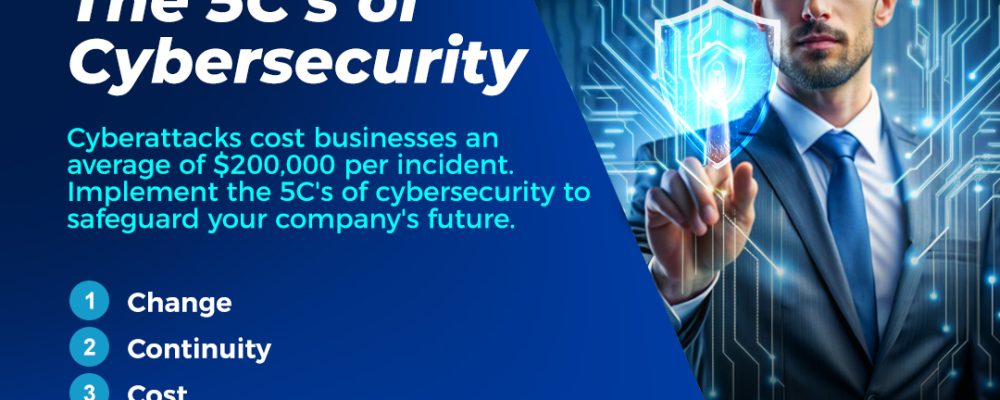All businesses rely significantly on various technology these days, and regrettably, this has made them easy targets for cyberattacks. Each cyberattack event costs small businesses, on average, $200,000, while larger organisations lose millions.
This should be concerning since corporate espionage may target your company as a primary target. Given the dynamic nature of cyber threats and the increasing determination of attackers, this should also raise serious concerns.
According to Sharad Agarwal, CEO of Cyber Gear, “These days, safety comes first, and the first step in ensuring system protection is to comprehend and implement cybersecurity measures. Cyber Gear in partnership with ProxySec, can help organisations effectively manage network resources and accomplish corporate objectives without hindrance by putting these procedures and practices into place.”
However, to maximize the benefits of cybersecurity, you need to be aware of the five essential C’s: Change, Continuity, Cost, Compliance, and Coverage.
Which five C’s apply to cybersecurity?
1. Change:
The field of cybersecurity is dynamic, with ever-evolving threats and vulnerabilities. Being flexible is essential to avoiding future problems. This means being up to date on the most recent threat intelligence, changing legal requirements, and developing technological trends.
Follow the latest developments in IT security and make the necessary adjustments. Attackers are only getting more skilled, and cyber risks are changing at an astounding rate.
Putting strong cybersecurity safeguards in place, such frequent software updates and network monitoring, is more important than ever. Along with developing procedures to secure consumer data, you should also undertake risk assessments and have strong incident response plans.
To achieve the highest level of safety, this C also mandates that you teach and acquaint your team with pertinent risks and best practices. These may cover topics such as:
- Regular network examinations and security control monitoring
- Creating data backups and efficient recovery plans
- upgrading and patching all software on computers
- Making secure passwords and staying away from public computers
2. Continuity:
Maintaining a continuous defense against possible threats requires ensuring continuity in cybersecurity measures. This entails putting strong business continuity and disaster recovery procedures in place to lessen the effects of any security incident and guarantee a prompt return to regular operations.
Sadly, even if you take all the required cybersecurity precautions, you could still become a target of cyberattacks. But that’s not the time to give up on everything. Establishing a continuity plan is crucial.
To do this, you must recognize and comprehend the risks that could harm your company. Data theft and the loss of confidential or private information could affect your company.
Create thorough disaster recovery policies and strategies after determining all possible cyberthreats that are specific to your company and their repercussions. An effective DRP provides your company with a road map for handling disruptive events.
3. Cost:
Maintaining a strong cybersecurity framework requires effective cost management. This entails evaluating and updating security investments continually in response to the changing threat landscape, as well as striking a balance between budgetary limits and the requirement to employ advanced security measures.
Similar to data breaches, any type of cybercrime can have a devastating financial impact on your company. This may do more harm to your digital systems and cause them to stop working.
To prevent the financial consequences of these dangers, it is imperative to have appropriate cybersecurity safeguards in place. Furthermore, resist the temptation to cut corners due to the expense of cybersecurity.
Of course, the total expenses might appear high, but they pale in comparison to the possible damages that could result from a cyberattack.
Furthermore, it’s critical to balance cost and risk when investing in cybersecurity because most firms have limited resources. This will assist you in selecting the best security options without going over budget or jeopardizing long-term security.
4. Compliance:
Adherence to current legal statutes and regulations is essential. Respecting legal mandates such as GDPR and HIPAA, among others, guarantees the safety of private data, helps to avert legal issues, and builds confidence with stakeholders and clients.
Operations in business are governed by several industry laws, rules, and standards. For example, the California Consumer Privacy Act (CCPA) mandates compliance with its rules by any businesses that offer goods or services in the state.
It is essential to comprehend all of the cybersecurity rules and regulations that apply to you, regardless of where you live. Additionally, make an effort to understand their necessity and how to adhere to them; professionals may always assist you in this regard.
Make sure you continue to comply after you’ve determined whatever rules and regulations are necessary. Otherwise, your company could be hit with thousands of dollars in penalties or even jail time for violating data privacy laws.
5. Coverage:
A thorough understanding of security protocols indicates how well an organization’s digital assets are safeguarded. To identify and mitigate possible attacks across all vectors, a comprehensive strategy to cybersecurity is necessary, spanning network, application, endpoint, and data security.
Your company is shielded from the financial consequences of cyberattacks with cybersecurity insurance. A strong policy can assist you in paying for things like legal fees, investigation costs, and customer refunds that come with the remediation process.
Determine whether assets are vulnerable to a cyberattack and carry out a risk assessment before to deciding on any insurance coverage. Next, ascertain whether the coverage that applies to you is adequate.
Furthermore, take note of the many kinds of cyber insurance coverage available. One is coverage for network business interruption, which is limited to net income loss during a cyberattack while your systems are still unavailable.
Conversely, network security coverage might pay out to clients in the event of a data breach and loss of private data. Make an informed decision by retaining the following in mind:
- Attack surfaces for your company
- Risk to third parties
- The standing of your insurance provider




